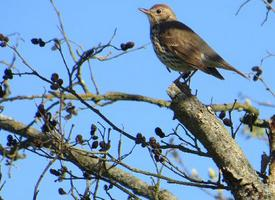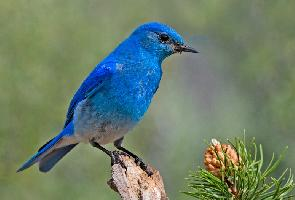
Greutăți și măsuri
| Lungime | de la 20 la 23,5 cm |
|---|---|
| Greutate | de la 50 la 107 g |
Date biologice
| Durata de viață | 3 r |
|---|
Descrierea animalului
The Song Thrush (Turdus philomelos) is a charming and melodious bird that belongs to the thrush family, Turdidae. It is a medium-sized bird, measuring about 20 to 23 cm in length, with a wingspan ranging from 33 to 36 cm. The bird is well-admired for its beautiful singing voice, from which it derives its name. The Song Thrush has a wide distribution, being found across much of Eurasia and has been introduced to New Zealand and Australia where it has established stable populations.Physical Characteristics:
The Song Thrush possesses a distinctive appearance that makes it relatively easy to identify. It has brown upperparts and creamy underparts, with the latter being adorned with dark, round spots that are a key identifying feature. The bird's head, back, and wings display varying shades of brown, with the intensity of the color varying among individuals. Its underwing is pale yellowish, visible during flight. The tail is relatively short and square. Both sexes appear similar in plumage, but juveniles can be distinguished by a more mottled appearance.
Habitat and Distribution:
Song Thrushes are adaptable birds, found in a variety of habitats including forests, gardens, parks, and farmland across Europe and into parts of Asia. They show a preference for areas with dense undergrowth or thick vegetation, which provides cover and nesting sites, as well as a rich supply of their invertebrate prey. In winter, some populations migrate southwards to warmer regions, while others remain in their breeding territories if food is abundant.
Diet and Feeding Habits:
The diet of the Song Thrush is diverse, consisting mainly of invertebrates such as earthworms, snails, and insects during the breeding season. It is famous for its method of feeding on snails by using a stone or hard surface as an 'anvil' to break the snail's shell. During the colder months, it supplements its diet with berries and fruits. This adaptability in feeding habits helps it to survive in a variety of environments.
Reproduction:
The breeding season for Song Thrushes typically begins in early spring. They are monogamous birds, with pairs forming strong bonds during the breeding season. The female is responsible for building a neat, cup-shaped nest made of grass, leaves, and mud, usually positioned in the fork of a tree or a bush. She lays a clutch of 3 to 5 blue or greenish eggs with black spots, which she incubates for about two weeks. Both parents then feed the chicks, which fledge approximately two weeks after hatching. Song Thrushes may have two or even three broods in a single breeding season.
Conservation Status:
The Song Thrush has experienced declines in parts of its range due to habitat loss, pesticide use, and changes in agricultural practices. However, it remains widespread and is classified as Least Concern by the International Union for Conservation of Nature (IUCN), indicating that it is not currently at significant risk of extinction.
Vocalizations:
The Song Thrush is celebrated for its vocal abilities. Its song is a complex and melodious sequence of phrases, often repeated two to four times before moving on to a new sequence. This repetition is a distinctive feature of its song, which can include a wide variety of mimicked sounds and notes. The bird sings from high perches and is often heard at dawn and dusk, adding a delightful soundtrack to its habitats.
In summary, the Song Thrush is a beautiful and adaptable bird, renowned for its melodious song and distinctive appearance. Despite facing challenges from habitat changes, it continues to thrive in a wide range of environments, bringing joy to those who have the pleasure of witnessing its song and presence.
Harta răspândirii

Animale similare
Fotografii noi cu animale
Top 10 animale
- Dolphin gull (Leucophaeus scoresbii)
- Diana monkey (Cercopithecus diana)
- Moustached guenon (Cercopithecus cephus)
- Greek tortoise (Testudo graeca)
- Stone loach (Barbatula barbatula)
- Galápagos tortoise (Geochelone nigra complex)
- Japanese macaque (Macaca fuscata)
- Russian tortoise (Testudo horsfieldii)
- Common flying dragon (Draco volans)
- Galápagos penguin (Spheniscus mendiculus)


